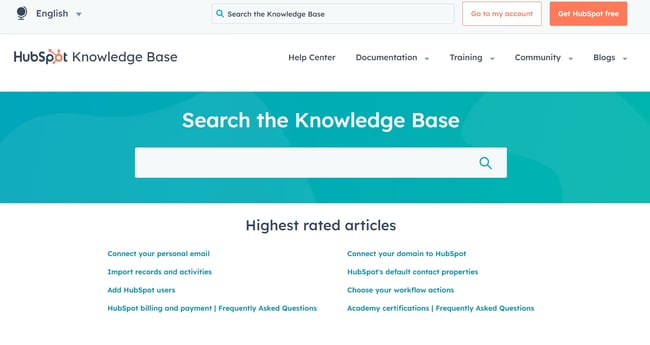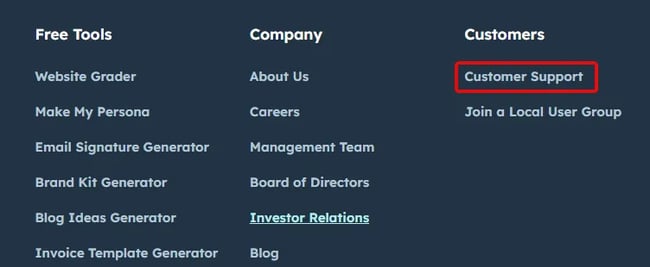If you're not using knowledge base content to offer a more streamlined, delightful experience for your customers, you're missing out. When it comes to customer loyalty, there are more brands to choose from than ever before. And if your company falls short in offering exceptional service, your customers will quickly seek out your competitors.

Need proof? 61% of Americans will switch companies due to poor customer service. There's some good news though — 60% of consumers have purchased something from one brand over another based on the service they expect to receive.
This is where a knowledge base alleviates friction for both your agents and your customers, as 81% of consumers expect more self-service options. So, how do you create an effective self-service content hub? Read on for eight essential steps to developing helpful knowledge base articles.
How to Produce the Best Knowledge Base Content
No two knowledge bases should be the same. There are, however, some guidelines you should follow to ensure your knowledge base content exceeds customer expectations. Let's dive in.
1. Create a comprehensive content strategy.
"Self-service is everything for scaling. Customers want answers on their own time and terms. The first step in any knowledge-base-building exercise is to understand what questions your customers are asking.
An easy way you can do this is to better track topics in your support tickets or chatbots. Those frequent topics customers want to dig into represent the best place to get started when building out content." — Michael Renahan, Senior Manager, Customer Success, at HubSpot
Following Michael's advice, your first step to producing superior knowledge base content is to plan it out as thoroughly as you can. To do so, answer these critical questions:
-
What do your customers need to know? What do they ask frequently in relation to your product?
-
What are your customers' most common pain points?
-
How can you best answer different customer queries or problems?
-
How will customers navigate your knowledge base?
-
Where does your knowledge base fit within your broader customer service strategies?
Answering these questions will help you devise a framework for your knowledge base content. You'll also be able to figure out what type of content is best for addressing each subject. Some popular content types include articles with screenshots or video guidance.
For example, a video troubleshooting guide may be useful for addressing a common product issue that customers face. An FAQ page, meanwhile, is better for clearing up questions about a service you provide.
 Pro Tip: Move your frequently asked product questions to the first screen so users get an immediate solution, as HubSpot did. Embed a search bar for a quick self-service. Below the fold, group other questions contextually in collections so visitors can easily navigate the page.
Pro Tip: Move your frequently asked product questions to the first screen so users get an immediate solution, as HubSpot did. Embed a search bar for a quick self-service. Below the fold, group other questions contextually in collections so visitors can easily navigate the page.
-1.webp?width=650&height=433&name=hubspot%20(1)-1.webp)
The most important thing is to provide your customers with several ways to discover the content they need.
2. Put yourself in your readers' shoes.
"Involve your customer success team in the KB creation process, as they are routinely in direct contact with the end-users and can provide valuable insights into their specific needs. Our collective goal is to consistently bolster the user experience and foster customer success." — Daniel Chabert, CEO and Founder of PurpleFire
Writing content from the perspective of the reader prevents writer bias from damaging your content.
Writer bias occurs when your deep knowledge of a subject negatively impacts the content that you're writing. You assume that your readers share your understanding of a topic, so you don't explain things as clearly as you need to. This narrows your audience down to more advanced users who probably don't need as much help from your knowledge base content.
That said, you should begin by getting a basic understanding of the audience viewing your content. Ask yourself: How do these consumers prefer to absorb information? Once you've figured this out, start to visualize how your customers feel when they're seeking help. Is a reader likely to be frustrated by a problem they're having with your product? Or, are they confused about a specific feature of your service?
Second, let your consumers tell you what they want and what they'd find helpful. To do so, ask your customers about tutorials they would like to see in your knowledge base. To collect as many answers as possible, reach your users via email, in-product, and website feedback surveys. You can do this seamlessly with Survicate, a tool for user journey surveys.

The answers to these questions will help you correctly position each piece of content.
"One rule I have is that when creating or editing a document, it's essential to write it as if you are a user that has no idea what this feature does or how to implement it, that way, you ensure that you don't miss any blind spots." — Rania Jamal, Head of Customer Experience at Userpilot
Pro Tip: To make sure writer bias isn't impacting the effectiveness of your content, consider hiring an editor who doesn't have tons of experience working with the product to read through it for clarity.
3. Make sure all content offers a valuable solution.
Another common mistake is forgetting the purpose of your knowledge base content and instead, using it as an opportunity to close a sale. You shouldn't be using tutorials to sell the benefits of your product. You can do that elsewhere on your website — but your knowledge base should be strictly informational. There shouldn't even be a slight undertone of selling.
Each piece of content in your knowledge base must offer a real solution to its readers and directly address the problem — one at a time. By doing so, you show that you understand each customer's pain points and are giving them the means to resolve it.
Get inspired by a great example of problem-centered knowledge base content by Lemlist, an outreach automation tool. The team puts customer success front and center and offers detailed tutorials on how to do X, accompanied by helpful tips users can enact to achieve higher reply rates.
"Transition from long, detailed articles (X) into shorter, step-by-step instructional content (Y) to accommodate users with different learning preferences and improve the overall content engagement. Use shorter paragraphs, bullet points, and numbered lists to present information more clearly. And opt for plain language whenever possible." — Daniel Chabert, CEO and Founder of PurpleFire
Pro Tip: Make sure that readers understand how to contact your support team, too, in the event that your knowledge base content doesn't provide an answer to their question.
4. Give knowledge base content real-world context.
Another superb way to ensure your content is relevant to readers is by giving it real-world context. This shows customers how to achieve success using your product or service, and provides an example. Rather than keeping things theoretical, include case studies of how real people or businesses use specific features to accomplish their goals.
Ahrefs, a world-known SEO platform, links to their blog content with use cases to deliver a comprehensive overview of feature X and its benefits. This way, Ahrefs' customers get the answer to the main question and discover other use cases they can consider.

Pro Tip: Remember, you're not selling via your customer support content. If a real-world example or case study doesn't answer a reader's question, don't include it.
5. Think visually with formatting & features.
Some companies take a sloppy approach to knowledge base content because it isn't sales or marketing material, so they think it deserves less attention. While landing pages are painstakingly devised, support content is too often thrown together haphazardly.
Take a serious approach to your knowledge base. Consider how you're stylizing your content, and think about the tone you're using. Additionally, spend some time thinking about how the way you format it will impact how consumers absorb information. You can't just throw together a collection of FAQs. Instead, explore the different content formats that'll appeal to different consumers. Effective options include:
- Video Tutorials
- Infographics
- How-To Guides
- Glossaries of Words and Phrases
Adding visual elements to content also improves its ability to convey information. Screenshots, graphs, and other features help your pieces show as well as tell.
Pro tip: Adding images to How-To guides can be tricky and time-consuming. A tool like HubSpot's free Guide Creator can simplify the process by using AI to automatically capture both the steps and the images.
For example, Survicate embeds video tutorials to guide its users on how to complete a relatively difficult or many-sided task. What's more, the company offers additional support by email and chat if the knowledge base article isn't enough.
Pro Tip: Apply best practices for formatting marketing pages to support content. Action-oriented headlines help readers find the most relevant information on your pages. Step-by-step lists and bullet points allow customers to scan your pieces more efficiently. Plus, structure gives the page better flow for reader experience.
6. Make your content easily accessible.
Your customers want answers to their questions as swiftly as possible. To ensure this, add a search bar to let users search for articles by topic or keywords. Link support pieces to help people research issues that may be related. Create a table of content with jumplinks in long guides, like Shopify:

Or Lemlist:
Next, think of places on the site where people can find your knowledge base. You never know when the users stumble upon the issues, so make sure to make it accessible from different places:
1. In the footer — HubSpot example.
2. In the navigation menu — Userpilot example.
3. In-app resource center — Asana example.
Also, consider the searchability of your content. After all, you want your customers to find the right articles when searching on your site or on Google. For this, do some keyword research to find out how people are searching for your content. Work relevant keywords into different page elements:
-
Article titles – Short, action-oriented titles with a primary keyword boost your search engine optimization efforts and guarantee your audience is able to easily find your knowledge base content.
-
Metadata – Ensure page descriptions have the phrases customers use most often to look for the answers the page offers.
-
Content body – Where it's natural to do so, add keywords to the body of your content. This should be easy since the keywords will often be used to answer the customer's question.
-
Anchor text – If you link between knowledge base articles, use keywords for the anchor text to boost SEO performance.
For example, Semrush's knowledge base ranks in the 1st position by numerous relevant keywords. So, next time an SEO specialist is looking for a guide to track featured snippets, the Semrush piece will be of help.
"We optimize the knowledge base for SEO because it improves content visibility in search engine results. This attracts more organic traffic and potentially increases the reach of our knowledge base.
"However, we balance SEO optimization and provide valuable, user-friendly content. Mind that with a heavy emphasis on keywords and search engine requirements, you may be sacrificing the user experience." — Vladyslav Podoliako, Founder of Folderly.
Pro Tip: Your knowledge base content shouldn't be buried — make sure even first-time visitors to your site are able to easily locate it. That means placing a CTA inviting users to check out the knowledge base in multiple locations, using a readable font, and making sure it shows up on mobile in a findable spot, too.
7. Update, adapt, and improve your knowledge base.
A key step to creating knowledge base content is understanding that it's an ongoing process. You'll be updating, adapting, and improving your knowledge base continually as your product evolves.
Customers hate looking for a support article and finding an outdated answer. Keep checking up on your knowledge base, and replace or edit pieces that need more current information. It's also important to collect customer feedback to improve your published content.
The best knowledge base content empowers as well as informs. And, while there's no perfect knowledge base page, you must tailor your guides and other pieces to suit your customers. Following these steps is the best way to ensure your content will truly deliver.
"Our Customer Experience team uses Asana for updating the knowledge base. The product team informs our CX team about any product updates or releases at least 10-14 days prior to a roll-out, giving the CX team time to update the knowledge base.
"Maintaining good communication with the product team is crucial to keep the teams aligned and ensure the KB is updated by the time the new features/updates are released." — Rania Jamal, Head of Customer Experience at Userpilot
Pro Tip: Make it a point to review your knowledge base content at least once a quarter, and when new product features are released.
8. Integrate AI assistants into live chats to spot confusing knowledge base documents.
You can use AI assistants in a live chat setting to provide speedy answers to customer requests. However, AI assistants can also help to detect repetitive or misleading information as they are trained on your knowledge base. If your AI assistant cannot find an appropriate document or offer a tutorial for a problem, it's a sign to check out those articles.
"We use a neutral tone of voice and simple language to help customers quickly find what they're looking for. Recently, we started using Intercom's AI assistant, which derives the answers to clients' questions from our KB. This is when we immediately saw which parts of the articles were confusing since AI provided not accurate answers.
"So now we keep both people and a bot in mind — everything should be as clear as possible. We try to make everything visually as neat as possible: we use tables of contents and sections to make the text understandable. We also visualize every possible example from the system." — Nina Novikova, Head of Customer Support at Reply.io
For more knowledge base tips, read about customer self-service.
Pro Tip: AI assistants are an incredible resource to help your customers get the information they need faster, but sometimes, customers will still want to chat with a human representative. Be sure that you place contact information in a findable location.
Getting Started
Knowledge bases empower customers to help themselves. When you get started creating helpful knowledge base content that keeps users happy and saves your service reps time, you'll clearly understand how invaluable it can be.
Editor's note: This post was originally published in March 2020 and has been updated for comprehensiveness.









![18 Best Knowledge Management Software [+ Free Options]](https://blog.hubspot.com/hubfs/99_SEO Strategy.png)
![What Is a Knowledge Base, and Why Do You Need One? [Definition]](https://blog.hubspot.com/hubfs/64_Small Business Marketing Strategy-1.png)



![How to Create Technical Documentation in 6 Easy Steps [+ Examples]](https://blog.hubspot.com/hubfs/technical documentation_featured.jpg)


![An Easy Guide to Writing Effective Knowledge Base Articles [+ Templates]](https://blog.hubspot.com/hubfs/knowledge-base-article-templates_0.webp)
